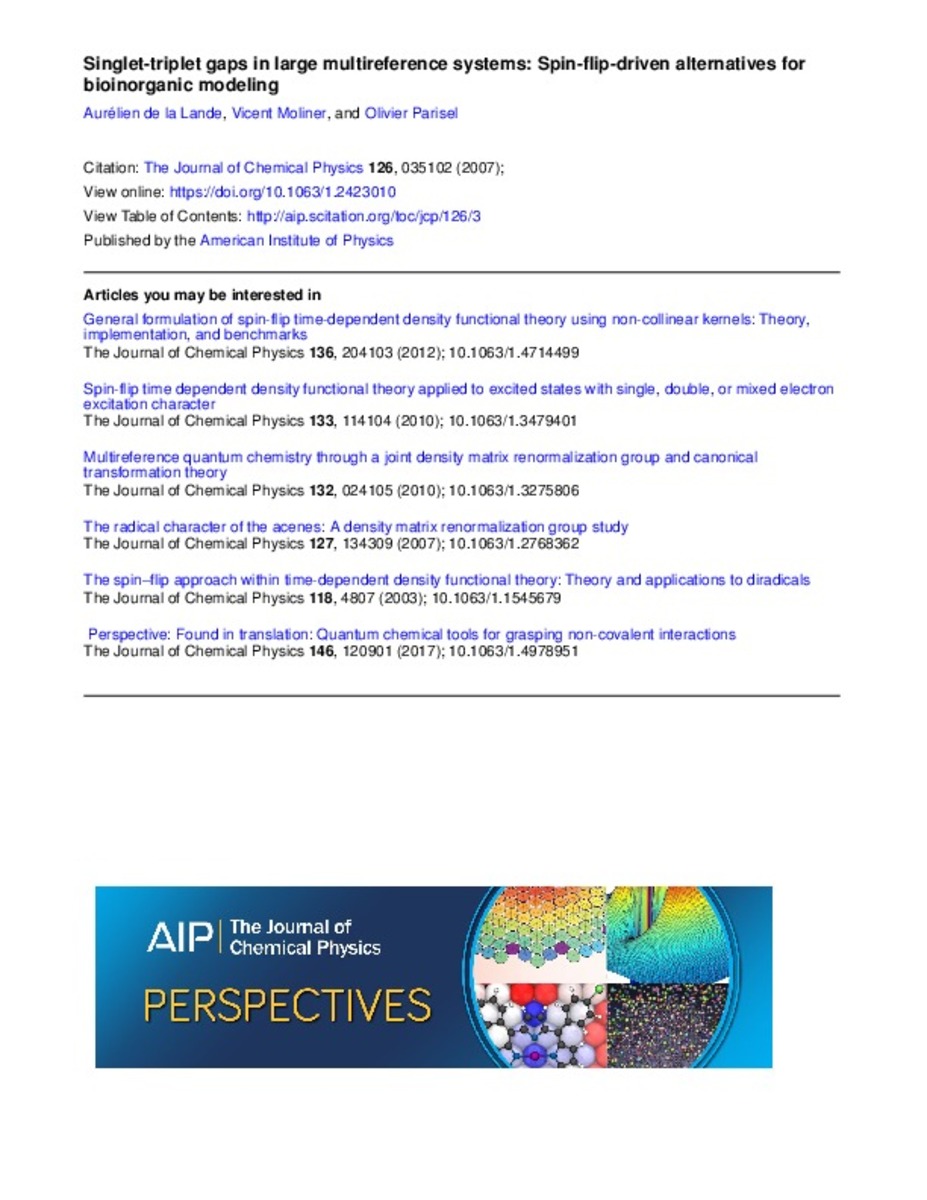Mostrar el registro sencillo del ítem
Singlet-triplet gaps in large multireference systems: spin-flip-driven alternatives for bioinorganic modelling
| dc.contributor.author | de la LANDE, Aurélien | |
| dc.contributor.author | Moliner, Vicent | |
| dc.contributor.author | Parisel, Olivier | |
| dc.date.accessioned | 2017-12-15T12:17:50Z | |
| dc.date.available | 2017-12-15T12:17:50Z | |
| dc.date.issued | 2007-07 | |
| dc.identifier.citation | DE LA LANDE, Aurélien; MOLINER, Vicent; PARISEL, Olivier. Singlet-triplet gaps in large multireference systems: Spin-flip-driven alternatives for bioinorganic modeling. The Journal of chemical physics, 2007, vol. 126, no 3, p. 01B613. | ca_CA |
| dc.identifier.uri | http://hdl.handle.net/10234/171039 | |
| dc.description.abstract | The proper description of low-spin states of open-shell systems, which are commonly encountered in the field of bioinorganic chemistry, rigorously requires using multireference ab initio methodologies. Such approaches are unfortunately very CPU-time consuming as dynamic correlation effects also have to be taken into account. The broken-symmetry unrestricted (spin-polarized) density functional theory (DFT) technique has been widely employed up to now to bypass that drawback, but despite a number of relative successes in the determination of singlet-triplet gaps, this framework cannot be considered as entirely satisfactory. In this contribution, we investigate some alternative ways relying on the spin-flip time-dependent DFT approach [Y. Shao et al. J. Chem. Phys. 118, 4807 (2003)]. Taking a few well-documented copper-dioxygen adducts as examples, we show that spin-flip (SF)-DFT computed singlet-triplet gaps compare very favorably to either experimental results or large-scale CASMP2 computations. Moreover, it is shown that this approach can be used to optimize geometries at a DFT level including some multireference effects. Finally, a clear-cut added value of the SF-DFT computations is drawn: if pure ab initio data are required, then the electronic excitations revealed by SF-DFT can be considered in designing dramatically reduced zeroth-order variational spaces to be used in subsequent multireference configuration interaction or multireference perturbation treatments. | ca_CA |
| dc.format.extent | 8 p. | ca_CA |
| dc.format.mimetype | application/pdf | ca_CA |
| dc.language.iso | eng | ca_CA |
| dc.publisher | American Institute of Physics | ca_CA |
| dc.rights | © 2007 American Institute of Physics. | ca_CA |
| dc.rights.uri | http://rightsstatements.org/vocab/InC/1.0/ | * |
| dc.subject | bioinorganic chemistry | ca_CA |
| dc.subject | bioinorganic modeling | ca_CA |
| dc.subject | singlet-triplet gaps | ca_CA |
| dc.subject | correlation methods | ca_CA |
| dc.subject | mathematical models | ca_CA |
| dc.subject | perturbation techniques | ca_CA |
| dc.subject | probability density function | ca_CA |
| dc.title | Singlet-triplet gaps in large multireference systems: spin-flip-driven alternatives for bioinorganic modelling | ca_CA |
| dc.type | info:eu-repo/semantics/article | ca_CA |
| dc.identifier.doi | https://doi.org/10.1063/1.2423010 | |
| dc.rights.accessRights | info:eu-repo/semantics/openAccess | ca_CA |
| dc.relation.publisherVersion | http://aip.scitation.org/doi/full/10.1063/1.2423010 | ca_CA |
| dc.type.version | info:eu-repo/semantics/publishedVersion | ca_CA |
Ficheros en el ítem
Este ítem aparece en la(s) siguiente(s) colección(ones)
-
QFA_Articles [817]
Articles de publicacions periòdiques







